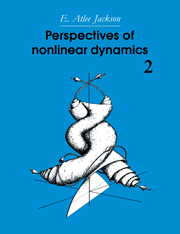Book contents
- Frontmatter
- Contents
- Preface
- Acknowledgements
- 6 Models based on second order difference equations
- 7 Models based on third order differential systems
- 8 ‘Moderate-order’ systems
- 9 Solitaires: solitons and nonsolitons
- 10 Coupled maps (CM) and cellular automata (CA)
- Epilogue: ‘Understanding’ complex systems: Order; organization; Endnote–models, causality, irreversibility
- Appendixes
- Bibliography
- References added at 1991 reprinting
- Cumulative index (Volumes 1 and 2)
10 - Coupled maps (CM) and cellular automata (CA)
Published online by Cambridge University Press: 19 February 2010
- Frontmatter
- Contents
- Preface
- Acknowledgements
- 6 Models based on second order difference equations
- 7 Models based on third order differential systems
- 8 ‘Moderate-order’ systems
- 9 Solitaires: solitons and nonsolitons
- 10 Coupled maps (CM) and cellular automata (CA)
- Epilogue: ‘Understanding’ complex systems: Order; organization; Endnote–models, causality, irreversibility
- Appendixes
- Bibliography
- References added at 1991 reprinting
- Cumulative index (Volumes 1 and 2)
Summary
An overview
In the previous chapters we have obtained a number of insights and perspectives concerning nonlinear dynamics with the help of various simplifying models. These models necessarily involve some mathematical paraphernalia, such as differential equations or maps (difference equations) in various dimensions. To put this chapter into context, it is useful to first organize and extend this range of mathematical methods of describing the dynamics of physical systems.
We began with models based on ordinary differential equations (ODE), which have one independent variable, which we usually take to be the time, t. Thus these models are characterized by n differentiate functions, x(t)∈Rn, of one continuous (‘independent’) variable, t ∈ R. In the case of models based on difference equations (DE), or maps, we generally still have n real functions, x(t)∈Rn, but the ‘time’ now is taken to be discrete. We denote this by t ∈ Z, where Z stands for all real integers. These models, all involving the one independent variable, t, may be usefully referred to as Lagrangian models.
We also considered rather briefly another Lagrangian class of models, in the studies of the influence of finite accuracy of computational and empirical methods. These involved lattice maps (LM) in which both the ‘time’ and the functions x1(t), …, xn(t) can only take integer vajues. Thus, for LM, we have t ∈ Z, and x(t)∈Zn (Z possibly mod(N)). Z may obviously also refer to any discrete set, not just the integers.
These Lagrangian models can be organized in a table. Looking at such a table, there is clearly at least one logical possibility missing, namely t ∈ R, x(t)∈Zn.
- Type
- Chapter
- Information
- Perspectives of Nonlinear Dynamics , pp. 427 - 504Publisher: Cambridge University PressPrint publication year: 1990

